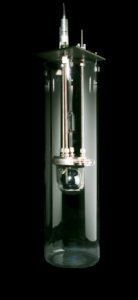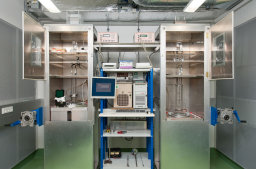Density
Realization of the unit of density
The density is defined as the ratio of the mass of a material and its volume. The SI unit is kg/m3.
According to the definition the density for a material is given, when its mass as well as its volume is known. Since the mass can be determined by a smaller relative uncertainty than the volume, to realize a density measurement is mostly a problem of the determination of the volume.

The following methods of the determination of density are applied at BEV:
- Geometrical determination of volume and weighing: optical measurement and weighing in air
- Flexural resonator measuring instruments: do not give a connection between “heavy” mass and the volume, but use the “inert” mass by bringing a sample to free vibrations
- Hydrostatic procedure: according to Archimedes’ principle a body immersed in a liquid loses apparently as much weight as the displaced amount of liquid weighs; the density is determined by this apparent loss of weight
- Pycnometric weighing procedure: the density is determined using volume standards (with known inner volume).

The most accurate density standards in use in metrology institutes are spheres and cubes made from silicon, hard metals, quartz glass and other special glasses with small extension coefficient. The density of liquids can be determined by means of these solid body density standards by hydrostatic weighing, especially the density of water and mercury. These are used as reference materials for density.